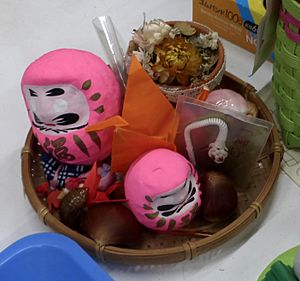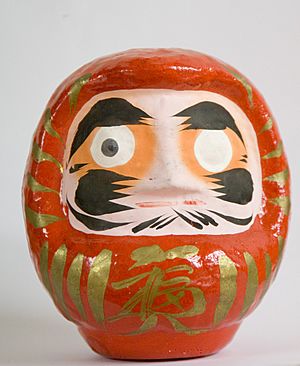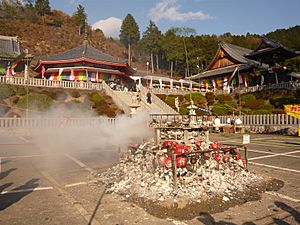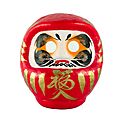Daruma doll facts for kids
The Daruma (達磨, daruma) doll is a hollow, round, traditional Japanese doll. It is modeled after Bodhidharma, the founder of the Zen sect of Buddhism.
The Daruma dolls are a kind of toy (omocha). The Daruma figurine is also a tumbler doll or roly-poly toy. When the doll is tumbled about, it rights itself. The two were well recognized as synonymous by the mid-19th century. Today, Daruma dolls are widely known, regardless of religion or sect.
Most daruma dolls are made of papier mache, and weighted at the bottom so the doll stands. The dolls are typically painted red. Darumas are sold with the eyes being white. Most daruma dolls are made in Takasaki City at the center of Japan. A fair is held in early January every year for the sale of darumas. Daruma dolls are symbols of good luck and business prosperity.
Color

Though it is not certain, the origins of Daruma's traditional red coloring probably came from the color of priest's robes. Reliable sources in English are hard to find, but one Japan-based website cites this red as being the "color of the robe of a high-ranking priest. The author then concludes that "since Daruma was the founder of the Zen Sect, he must have worn a red robe." The art historian James T. Ulak has documented a history of depictions of the Bodhidharma wearing lavish red robes, prior to representations of him as a doll, in an article entitled "Japanese Works in The Art Institute of Chicago."
By virtue of his red robes, Daruma has come to play a role in recovering from sickness. During the late Edo period (1603-1868), red was believed to have a strong association to smallpox. Hartmut O. Rotermond, author of Demonic Affliction or Contagious Disease?, describes that in Edo and surrounding cities, there were many outbreaks of measles and smallpox. In present-day Japan, there are many red shrines dedicated to a God of Smallpox, which had a particular liking for red. These shrines were built in response to those outbreaks. Believing that the God of smallpox, if pleased, would spare the afflicted child, the Japanese would often stretch out ropes around the house strung with red paper strips, have the child wear a red robe, and make a small altar for the God to put talisman-like Daruma figurines on. These precautions were also used to warn others that sickness was in the house, and to encourage cleanliness around the sick. The red of Daruma, however, was used to pacify the God, while the image of okiagari was to encourage the patient to recover as quickly as they fell ill. Daruma are also sold as a set of five colors – blue, yellow, red, white and black – called Goshiki Daruma. These days, daruma can also be found in colors other than red, including gold, which is meant to bring luck in financial matters.
Daruma eyes
Dolls are sold without the eyes painted in. The custom is to make a resolution or a wish and darken the left eye of the daruma. When the resolution or the wish is fulfilled, the right eye is also darkened. One explanation how this custom started says that in order to motivate Daruma-san to grant your wish, you promise to give him full sight once the goal is accomplished. This practice might also have something to do with the "enlightenment", the ideal attainment of Buddhism. This custom has led to a phrase in Japanese translated as "Both Eyes Open". Referring to "opening" the second eye, it expresses the realization of a goal. Traditionally, the Daruma was purchased as a household item, and only the head of the household would paint in the eyes.
One example of this is politicians during election time. Political parties have often been shown at their headquarters with large Daruma dolls and amulets purchased from local temples as a prayer for victory. This practice was highlighted in a 1967 article in Time magazine: "Last week, in the Tokyo headquarters of Japan's ruling Liberal Democratic Party, Premier Eisaku Satō dipped a sumi brush into an ink stone and with swift strokes daubed in the dark right eye of his Daruma. 'The eyes,' he remarked when he had finished, 'are as big as my own.'"
Facial hair
Daruma's facial hair is a symbolic representation of the animals well known in Asian culture to embody longevity: the crane and the tortoise. The eyebrows are in the shape of a crane, while the cheek hair resembles the shell of the tortoise. A Japanese-based website states that originally, there was a snake or dragon depicted across the moustache and cheeks, but was changed to tortoise to emphasize the desire for longevity. In this way, Daruma was designed to match the Japanese proverb "The crane lives 1000 years, the tortoise 10,000 years".
Daruma burning
At the end of the year, all the Daruma are brought back to the temple they were purchased from for a traditional burning ceremony. This ceremony, called the daruma kuyō (だるま供養), is held once a year, usually right after New Year's Day. The most renowned of these events are held at the Nishi-Arai Daishi Temple (Tokyo), and the Dairyū-ji Temple (Gifu). At these events, people bring the Daruma figures they had used that year to the temple. After expressing gratitude to them, they turn them over to the temple and buy new ones for the next year. All of the old Daruma figures are burnt together in the temple. After a solemn display of the monks' entry, reading of the sutras and blowing of horns, the tens of thousands of figurines are then set aflame.
Images for kids
-
Bodhidharma, woodblock print by Yoshitoshi, 1887
-
A wooden mold for a papier-mâché Maneki-neko and Okiagari-Koboshi Daruma figure from the Edo Period, 18th century. Brooklyn Museum.
See also
 In Spanish: Daruma para niños
In Spanish: Daruma para niños









